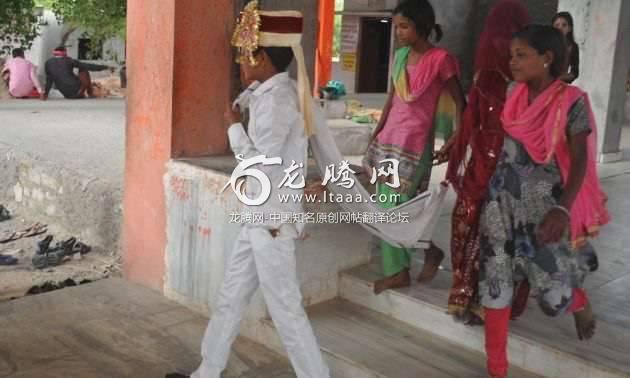童婚继续给21世纪的印度带来创伤 [美国媒体]
印度许多地区仍有婴儿和儿童结婚的现象,尽管几十年来这种习俗都是非法的。
Child marriage continues to traumatize 21st century India
童婚继续给21世纪的印度带来创伤
By ROHIT JAIN @ROHITJAIN217 JANUARY 3, 2018 6:45 PM (UTC+8)
罗希特·贾恩报道,@ROHITJAIN217,2018年1月3日下午 6:45(UTC+8)
(Child marriage continues to hurt youngsters in India, leading to widespread exploitation of girls at a tender age. Photo: Rohit Jain)
(童婚继续伤害着印度的年轻人,导致女孩在幼年时就受到广泛的剥削。 照片:罗希特·贾恩)
Infants and children continue to be married off in many parts of India despite the custom being illegal for decades
印度许多地区仍有婴儿和儿童结婚的现象,尽管几十年来这种习俗都是非法的。
Children in many parts of India continue to be forced into marriage despite a decades-old law banning girls under the age of 18 – and boys under 21 – from marrying. This has been a longstanding problem that has lead to widespread exploitation of young girls, as well as stealing their childhood.
尽管过去几十年来,法律都禁止18岁以下的女孩——和21岁以下的男孩——结婚,但是在印度的许多地区仍然有儿童被迫结婚。这是一个长期存在的问题,导致了对年轻女孩的广泛剥削,就如同盗毁了她们的童年。
Take the case of 13-year-old Jasmeena (not her real name). She was married off to a man seven years older. By 16 she was a mother of two children. When she turned 18, her husband abandoned her. With no means of support, she returned to her father’s home. The husband showed up months later and tried to rape Jasmeena, who fled trembling and traumatized. “I don’t ever want to go back to him,” she said.
以13岁的贾斯弥娜(化名)为例。 她嫁给了一个比她大七岁的男人。 16岁时,她已经是两个孩子的母亲。 而当她18岁时,她的丈夫抛弃了她。 由于没有任何经济支撑,她只得回到父亲家中。 其丈夫几个月后又出现了,并且试图强奸贾斯弥娜,她吓得浑身颤抖,带着心理创伤逃走了。 她说:“我再也不想回到他身边了。”
Such instances of trauma inflicted through forced child marriage are common despite the custom being illegal.
尽管这种习俗是非法的,但这种通过强迫童婚造成的创伤还是很常见。
Peeping over 16-year-old Haseena’s shoulder is her seven-year-old sister Nazma, who said: “I was only a breastfeeding infant … I did not even know what was happening when they married me off.”
十六岁的海丝娜,她七岁大的妹妹纳兹玛从其肩膀偷偷窥看过来说:“当他们把我娶走的时候,我还只是一个靠母乳喂养的婴儿…… 我甚至都不知道发生了什么。”
Nazma is worried about her fellow child bride, Haseena, who will be sent to her husband’s house. “What will happen to her education? We want to go to school! We want to study,” Nazma says.
纳兹玛担心她的伙伴海丝娜,作为童婚新娘就要被送到丈夫家了。 纳兹玛说:“她以后的教育会怎么样? 我们想要上学! 我们想学习。”
Early marriages affect many more girls than boys – they constitute 76% of all child-marriage victims. An analysis of Census 2011 data by IndiaSpend shows that 12.7 million women were forced to become child brides in India.
受早婚影响的女孩数量要多于男孩——占所有童婚受害者的76%。 根据IndiaSpend 于2011年的人口普查数据分析显示,印度有1270万妇女被迫成为童婚新娘。
Some children resist as best as they can. Aarti is a prime example. When her parents tried to get her married at 14, Aarti defied everyone and refused. She is now pursuing her studies in the 10th standard year at high school.
也有些孩子在尽可能地抵抗。 阿尔蒂就是一个很好的例子。 当她的父母在她14岁的时候就试图让她结婚的时候,阿尔蒂不顾一切地拒绝了。 她现在正在为学业奋斗,读的是高中标准十年级的课程。
While the law has failed to stop child marriage, activists can intervene through close engagement with communities and by talking to parents to make them understand how much the practice harms their children, Indira Pancholi, whoruns anti-child marriage campaigns in Ajmer with Mahila Jan Adhikar Samiti (MJAS), said.
英迪拉·潘卓丽表示:“尽管法律未能阻止童婚,但是社会活动人士可以通过与社区的密切接触进行干预,而且通过与父母的交谈沟通,可以让他们了解到童婚对他们子女的实际危害到底有多大。”她与马希拉·简·阿杜卡·萨米蒂在印度阿杰梅尔开展着反童婚运动。
According to the 2016 National Family Health Survey, about 42% of women aged between 20-24 years, were married before reaching the legal age of 18 in the state of West Bengal. But Haq Centre for Child Rights said the figures were far higher – 61% and 58% for the West Bengal districts of Murishidabad and Birbhum districts respectively.
根据2016年印度全国家庭健康调查,在西孟加拉邦,处于20-24岁年龄段的妇女中约有42%,在未达到18岁的法定适婚年龄之前就结婚了。 但是哈克儿童权利中心却说,这个数字要远远高得多,西孟加拉邦的穆里希达巴德区和布尔布姆区分别达到了61%和58%。
Many village elders still endorse child marriages. One explained: “All this dressing up and the make-up that the girls do are to lure boys. Parents must ensure that they send the girl to her in-law’s house before she gets her period,” an elder told Asia Times.
许多村庄的长者仍然认可童婚。 其中一位解释说:“所有这些穿着打扮以及女孩们化妆都是为了引诱男孩子。 父母必须确保他们在她长大到法定适婚年龄之前,就把女孩送到岳父家去。”,这位长者就是这样告诉亚洲时报的。
However, there is hope, as “survivors” of child marriage take up the responsibility of fighting to end it.
然而,希望依旧存在,作为童婚习俗的“幸存者”,要肩负起反对童婚终结这一恶俗的责任。
“If I could have my way, I’d ensure that nobody could be married before they were 18,” said Mamuni – a mother herself – who attended school despite taunts from her neighbors in a village in West Bengal.
“如果我可以按自己的方式行事,我会确保没有人会在18岁之前就结婚”,玛蒙妮——一位童婚母亲如是说。她自己坚持上学,尽管在这个西孟加拉邦的村庄里邻居们都嘲笑她。
(The author visited over 40 villages across Rajasthan and West Bengal in the course of his research on child marriage).
(为了写这篇研究童婚的文章,期间作者走访了拉贾斯坦邦和西孟加拉邦的40多个村庄)。
版权声明
我们致力于传递世界各地老百姓最真实、最直接、最详尽的对中国的看法
【版权与免责声明】如发现内容存在版权问题,烦请提供相关信息发邮件,
我们将及时沟通与处理。本站内容除非来源注明五毛网,否则均为网友转载,涉及言论、版权与本站无关。
本文仅代表作者观点,不代表本站立场。
本文来自网络,如有侵权及时联系本网站。
图文文章RECOMMEND
热门文章HOT NEWS
-
1
Why do most people who have a positive view of China have been to ...
- 2
- 3
- 4
- 5
- 6
- 7
- 8
- 9
- 10
推荐文章HOT NEWS
-
1
Why do most people who have a positive view of China have been to ...
- 2
- 3
- 4
- 5
- 6
- 7
- 8
- 9
- 10











